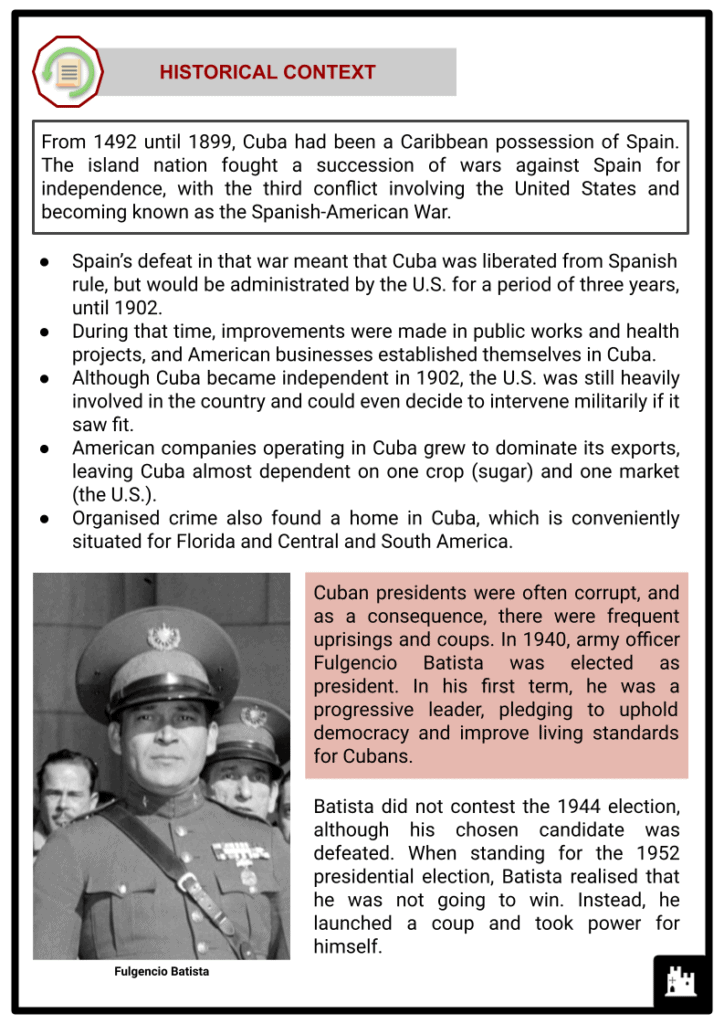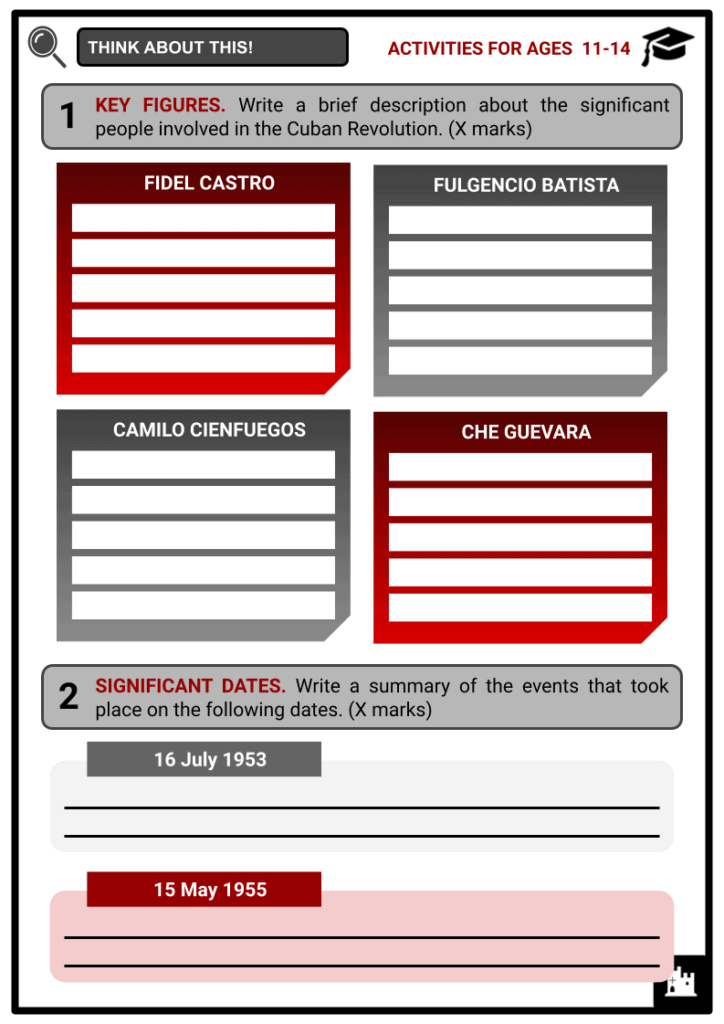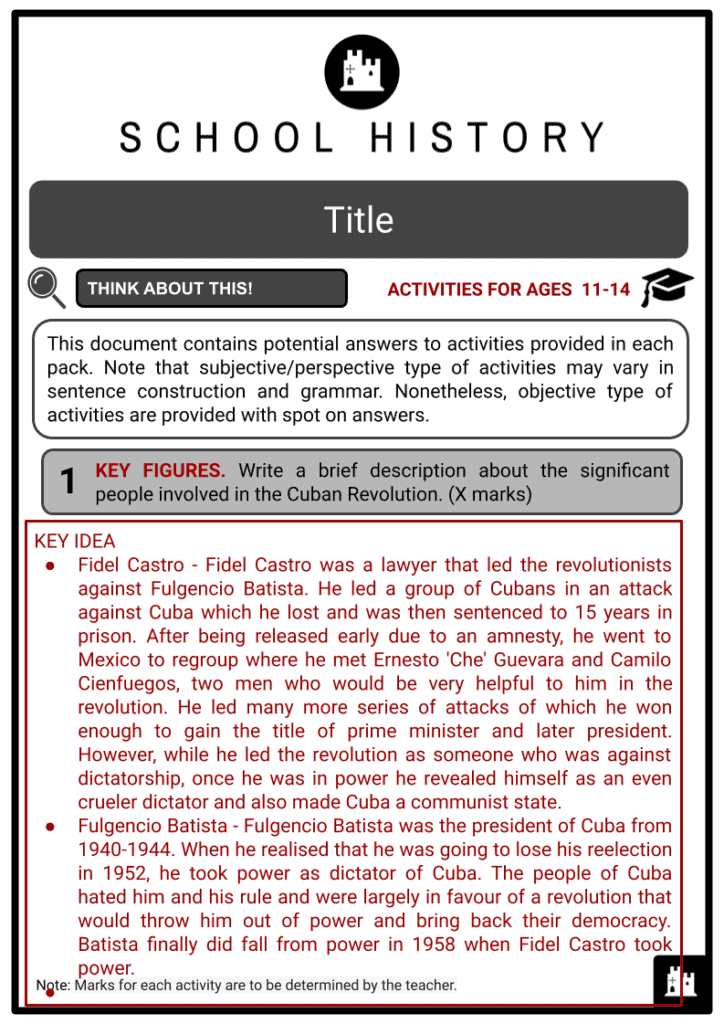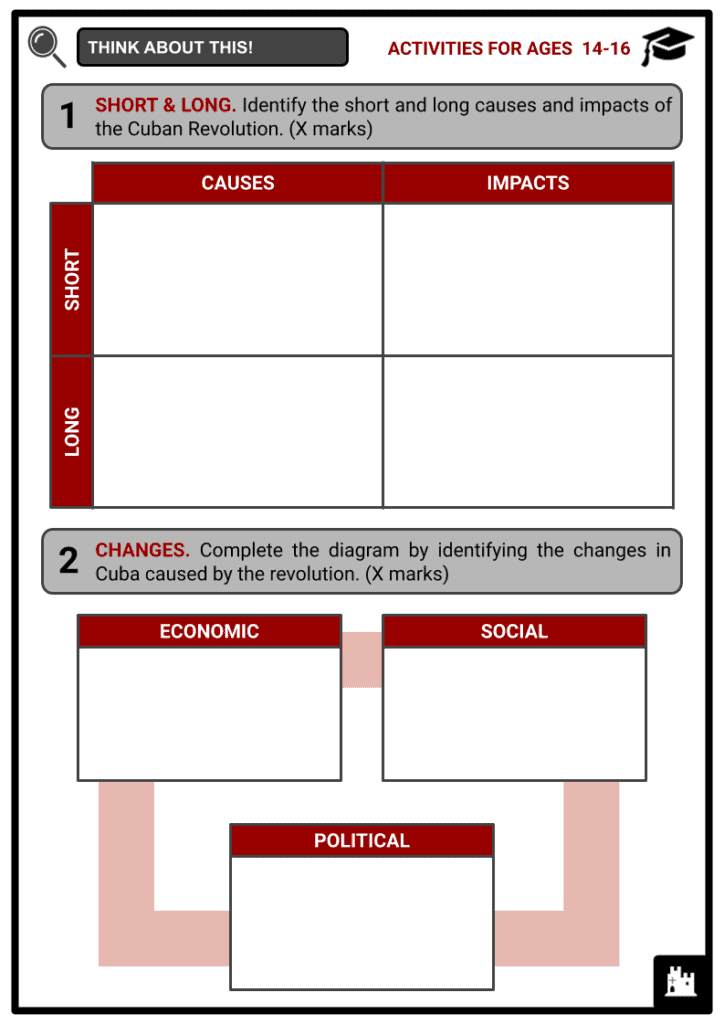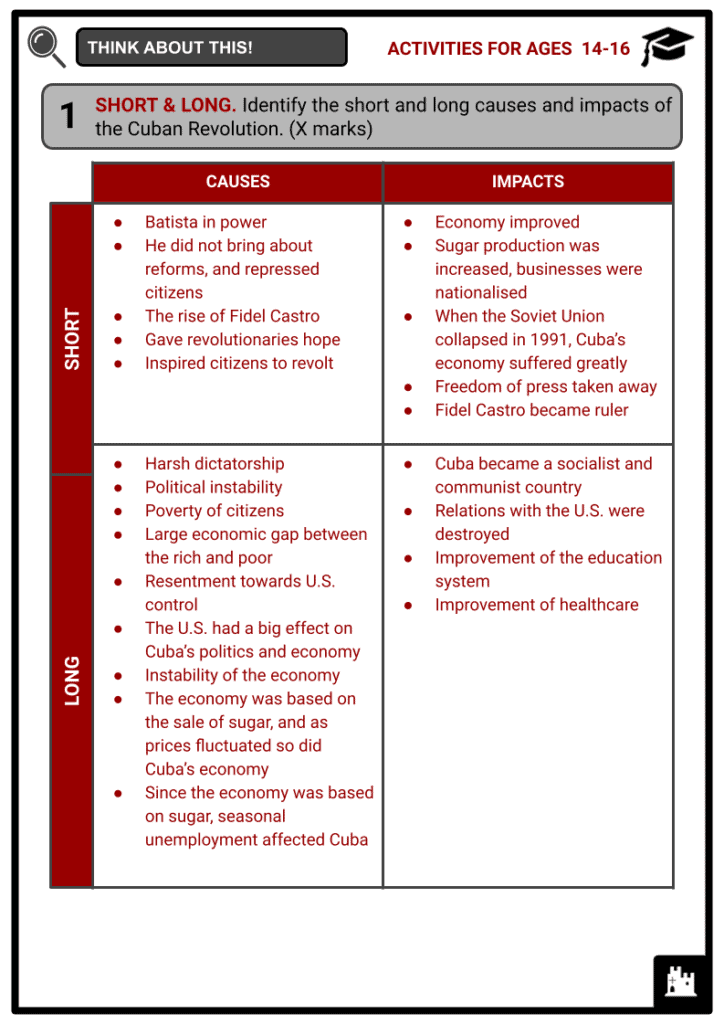Download the Cuban Revolution Worksheets
Do you want to save dozens of hours in time? Get your evenings and weekends back? Be able to teach the Cuban Revolution to your students?
Our worksheet bundle includes a fact file and printable worksheets and student activities. Perfect for both the classroom and homeschooling!
Table of Contents
Add a header to begin generating the table of contents
Summary
- Historical Context behind the Cuban Revolution
- The Course and Key Events of the Cuban Revolution
- Aftermath and Legacy of the Cuban Revolution
Key Facts And Information
Let’s know more about the Cuban Revolution!
- The Cuban Revolution was an armed revolt led by Fidel Castro and his fellow revolutionaries against the military dictatorship of Cuban President Fulgencio Batista. The revolt began on 26 July 1953 with a failed assault on Cuban military barracks. By the end of 1958, the guerrilla revolutionaries in Castro’s 26th of July Movement had gained the upper hand in Cuba, forcing Batista to flee the island on 1 January 1959.
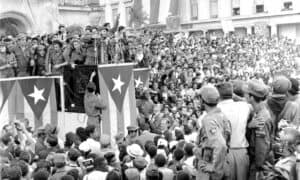
- From 1492 until 1899, Cuba had been a Caribbean possession of Spain. The island nation fought a succession of wars against Spain for independence, with the third conflict involving the United States and becoming known as the Spanish-American War.
- Spain’s defeat in that war meant that Cuba was liberated from Spanish rule, but would be administrated by the U.S. for a period of three years, until 1902.
- During that time, improvements were made in public works and health projects, and American businesses established themselves in Cuba.
- Although Cuba became independent in 1902, the U.S. was still heavily involved in the country and could even decide to intervene militarily if it saw fit.
- American companies operating in Cuba grew to dominate its exports, leaving Cuba almost dependent on one crop (sugar) and one market (the U.S.).
- Organised crime also found a home in Cuba, which is conveniently situated for Florida and Central and South America.
- Cuban presidents were often corrupt, and as a consequence, there were frequent uprisings and coups. In 1940, army officer Fulgencio Batista was elected as president. In his first term, he was a progressive leader, pledging to uphold democracy and improve living standards for Cubans.
- Batista did not contest the 1944 election, although his chosen candidate was defeated. When standing for the 1952 presidential election, Batista realised that he was not going to win. Instead, he launched a coup and took power for himself.
- Also standing in 1952, for a seat in the House of Representatives, was young lawyer Fidel Castro. When Batista cancelled the election, Castro tried to use the courts to topple him from power. When these attempts failed, Castro decided that he needed to launch an armed revolution to free Cuba from Batista’s dictatorship.
The Cuban Revolution
- Together with his brother Raúl, Fidel Castro founded an organisation called ‘The Movement’ in 1952. By the end of the year, it had well over a thousand members and a stockpile of weapons. On 26 July 1953, the Movement carried out an attack on the Moncada Barracks in Santiago de Cuba. Of around 160 revolutionaries taking part in the attack, nearly all were killed or captured.
- Fidel and Raúl Castro were among just 20 rebels who escaped into the nearby Sierra Maestra mountains. However, President Batista was able to swiftly round up the fugitives, and the Castros were imprisoned. At his trial, Fidel Castro spoke for several hours to defend his actions and condemn Batista. His concluding words were “History will absolve me”.
- At another presidential election in 1954, Batista was duly elected without opposition.
- Despite the way in which he had taken power, Batista’s regime was recognised by the United States.
- During the election, Castro’s supporters had campaigned for him to be released in an amnesty for political prisoners.
- Batista now felt that his position was strong enough that he had nothing to fear from Castro’s Movement, and he agreed to free the Castro brothers and many other political prisoners.
- Leaving prison in May 1955, Fidel and Raúl Castro found that their freedoms in Cuba were being restricted under Batista’s regime.
- Concerned that they would be arrested again, the brothers and several fellow revolutionaries left the country for Mexico.
- It was in Mexico that they met the Argentinian doctor Ernesto ‘Che’ Guevara. The revolutionary Guevara would become one of their closest associates. While in exile, Fidel Castro prepared to re-enter Cuba and dislodge Batista by force.
- He visited the U.S. to raise money for his campaign and trained his band of rebels, now named the 26th of July Movement after the attack on the Moncada Barracks, for combat. He also kept in touch with other revolutionary groups back in Cuba, so that they could coordinate their attacks for maximum effectiveness.
- On 25 November 1956, 82 members of the 26th of July Movement left Mexico aboard the yacht Granma.
- The boat arrived at Playa Las Coloradas in south-west Cuba on 2 December, and the rebels immediately headed for the relative safety of the Sierra Maestra mountains, from where they could conduct a guerrilla campaign.
- However, attacks by Batista’s troops severely reduced their numbers and barely a quarter of the original invasion force made it through.
- Both the Castro brothers, Che Guevara and Camilo Cienfuegos were among the survivors.
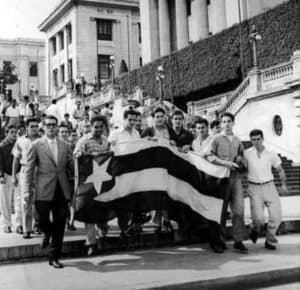
- The rebels then embarked on a period of raiding local army installations and recruiting new members for their movement. Meanwhile, elsewhere in Cuba, other revolutionary cells were carrying out anti-government activity.
- On 13 March 1957, the Revolutionary Directorate, a group comprising mostly students, tried to storm the presidential palace in Havana to assassinate Batista. The attack failed and there were terrible reprisals from the authorities.
- As Batista’s regime grew more repressive, support from the U.S. started to waver. Castro was inviting journalists and film crews to his mountain hideouts to tell the world about the justice of his cause and was winning sympathy from far outside the borders of Cuba.
- Money and supplies from abroad began to find their way to Castro, and some foreigners even came to Cuba to fight against Batista, notably the American William Morgan, who rose to the rank of comandante in a rebel band fighting in the Escambray Mountains of central Cuba.
- By 1958, Batista was feeling the pressure. The U.S. had stopped sending him weapons and he was finding it hard to equip his army. He decided to try and crush Castro once and for all, launching Operation Verano in the summer. Government troops surrounded Castro’s Sierra Maestra stronghold. Batista had overestimated the number of rebels that were there and so his army vastly outnumbered them.
- However, Castro’s men and women were by that time experienced guerrilla fighters who knew the terrain extremely well. They had networks of local people who would supply them with information about the army’s movements and plans.
- On 11 July 1958, government troops began the Battle of La Plata, entering the mountains from the sea to the south and advancing towards Castro’s base. However, Castro was ready for them, ambushing the soldiers en route and cutting off their escape route. The battalion commander refused to surrender for many days but finally capitulated to Castro on 21 July.
- The army commander, General Cantillo, decided to try and lure Castro out using another battalion, which he would strategically withdraw in the hope that the rebels would again deploy an ambush.
- This time the government troops were ready, another force of them waiting to launch a surprise attack on the rebels. This was the Battle of Las Mercedes, beginning on 29 July 1958, and this time the army did get the better of Castro’s guerrillas.
- Fearing his forces would be wiped out, Castro requested a ceasefire, but during negotiations, his fighters began disappearing back into the mountains. When the talks ended, General Cantillo prepared to resume hostilities on 8 August but found his enemies had vanished. Batista’s gambit had failed – Castro was still at large and army morale was in tatters.
- On 21 August 1958, Castro launched an offensive of his own. Coming out of the mountains, he began advancing north, splitting his forces into three columns under Jaime Vega, Che Guevara and Camilo Cienfuegos.
- Vega’s column was stopped by Batista’s troops, but the other two made it to central Cuba, joining up with other rebel groups.
- From 19-30 December 1958, Cienfuegos besieged the army garrison at Yaguajay.
- When the garrison finally surrendered due to lack of ammunition, Cienfuegos was hailed as the ‘Hero of Yaguajay’.
- Meanwhile, Che Guevara was advancing on Santa Clara, arriving on 28 December. Batista had ordered an armoured train to be sent to the town, carrying vital weapons and supplies.
- During the Battle for Santa Clara, Guevara managed to bend the railway track using a bulldozer, causing the derailment and capture of the government train. Batista realised that the end of his rule in Cuba had come, and fled the country on 1 January 1959. On 3 January, Guevara and Cienfuegos advanced unopposed into Havana. Fidel Castro arrived on 8 January, and the Cuban Revolution was complete.
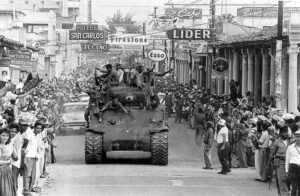
- Castro would rule for many decades as a communist dictator. At first, he had claimed not to be a communist, but this might have been so that he would appear less radical to his supporters around the world, including in the U.S.
Aftermath and Legacy
- The Castro brothers soon consolidated their power, wiping away all remains of the Batista administration and erasing any rival rebel groups that had supported them in their journey to power. Raúl Castro and Che Guevara were given the task of creating teams to pick up ‘war criminals’ from the Batista era who had engaged in torture and murder during the previous regime, and bring them to trial and execution.
- Although Castro began as a nationalist, he soon shifted his allegiance to communism and actively courted the Soviet Union’s leaders. For decades, communist Cuba would be a thorn in America’s side, causing international catastrophes such as the Bay of Pigs and the Cuban Missile Crisis.
- The United States imposed a trade embargo in 1962 that led to years of hardship for the Cuban people.
- Cuba emerged as a global actor under Castro’s leadership. The most famous example is Cuba’s intervention in Angola in the 1970s, when thousands of Cuban troops were sent there to back a socialist revolution. The Cuban Revolution inspired revolutionaries all over Latin America, as idealistic young men and women took up arms in an attempt to overthrow despised governments and replace them with new ones.
- Sandinista rebels eventually overthrew the government and took power in Nicaragua.
- Right-wing military administrations seized control in the southern half of South America as a result of the rise of Marxist revolutionary organisations such as Chile’s MIR and Uruguay’s Tupamaros (Chilean dictator Augusto Pinochet is a prime example).
- Through Operation Condor, these repressive governments united to wage a terror campaign against their own citizens.
- The Marxist uprisings were put down, but many innocent citizens died in the process.
- Cuba and the United States, on the other hand, maintained a tense relationship well into the 21st century. Over time, waves of migrants have left the island nation, changing the ethnic mix of Miami and South Florida. In 1980 alone, more than 125,000 Cubans fled in improvised boats in what became known as the Mariel Boatlift.


